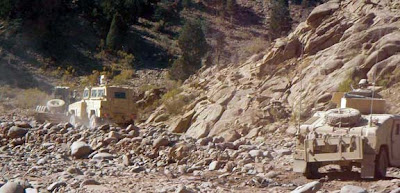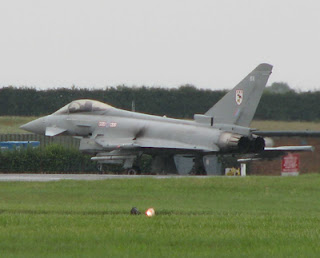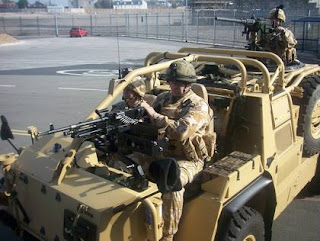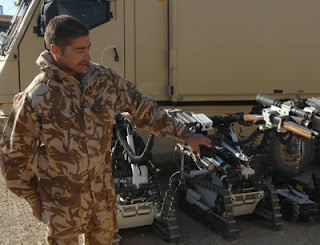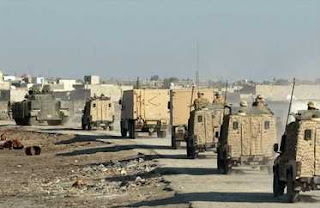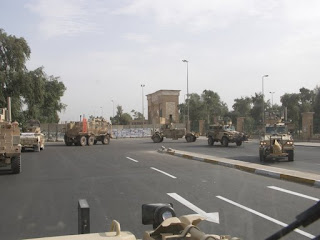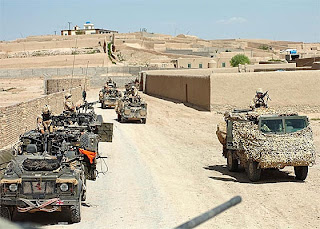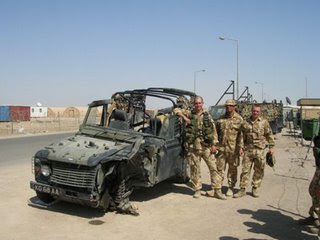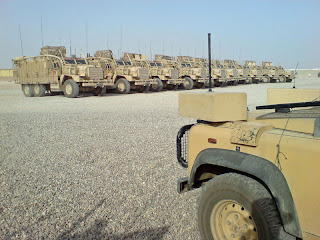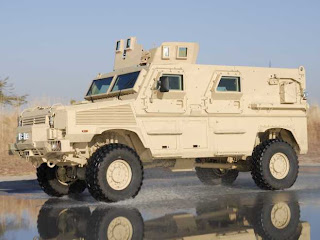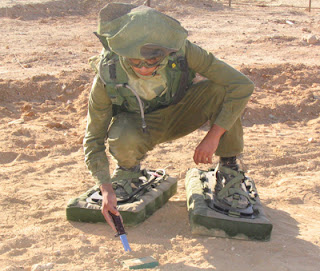
In what may be part of a co-ordinated fight against being forced to acquire protected vehicles, David Axe, freelance journalist
extraordinaire, has been given a license by the Army to take a pop at the Mastiff in an article written for
World Politics Review. In it, he argues that, "for British forces in Iraq, protection means loss of effectiveness".
No one can deny that the man has had first hand experience, having been embedded with British troops in Iraq – or that he writes well and makes an arguable case. But he is still wrong. Like so many of his ilk – including Michael Yon – he is perhaps too close to the ground and cannot see the bigger picture. A truism it may be, but the spectator sees more of the game.
To lead us into his thesis, Axe acquaints us with a Royal Air Force security troops patrolling the outskirts of Basra air station in southern Iraq on 17 December. The soldiers leap out of their new Mastiff armoured trucks in order to scout out a bridge before the lumbering blast-proof vehicles crossed. One of the soldiers notices something he didn't recall seeing before: a crack in the concrete near the far side of the bridge.
He points this out to his commander, Flight Lt. Edward Cripps, who eyes the idling Mastiffs, their drivers waiting for the all clear. This is what happens, Cripps muses aloud, when you repeatedly drive 30-ton trucks over a bridge designed for much lighter vehicles. "We'll have to keep an eye on this," he says. But for now the bridge was sound, and the officer gestures for the Mastiffs to cross.
This, Axe now develops, noting that, although this may be "a small thing", the over-burdened bridge is "just one consequence of the changing nature of British military operations in southern Iraq." Two years ago, he continues:
… nimble, lightly-equipped British forces pursued a counterinsurgency strategy grounded in decades of operational experience - and with unusual effectiveness. So much so that heavy, aggressive US forces adopted British methods when they launched their much-vaunted "surge" campaign to retake Baghdad from insurgents.
Today, the British counterinsurgency operation has ended - some say prematurely - and the units slated to remain in Iraq as an "overwatch" force have adopted heavier, less agile weapons systems, such as the Mastiffs, and fortified themselves at the air station.
In doing so, they become less effective against low-intensity threats and, ironically, more vulnerable overall. British forces, say some military experts, in essence are making the same mistake their American counterparts did in the first three years of the Iraq war: they have confused "force protection" with effectiveness.
Now working from
the particular to the general, Axe uses US military historian Max Boot, writing in the
Los Angeles Times in 2005, to bolster his case, with a direct quote from the piece:
Successful counterinsurgency operations require troops to go out among the people, gathering intelligence and building goodwill. But few Iraqis are allowed on these bases, and few Americans are allowed out - and then only in forbidding armored convoys.
We then learn, according to Boot's contention, that troops concentrated at large fortified bases surrendered intelligence-gathering and initiative - that is, the ability to act first and compel your enemy to react - in a bid to minimise soldiers' exposure to attack. And when they did sortie from their castle-like compounds, they were so ignorant of what qualifies for normal in Iraq that they were prone to respond to the most innocuous activity with gunfire.
Before going too far with this, however, it is useful to step back and examine Axe's first premise, that the heavyweight Mastiff is causing damage, something he refers to later in his article, adding that they tear down city power and telephone lines, damage buildings and parked cars and over-stress dilapidated Iraqi bridges.

Staying with this, we have to examine the very specific use to which the Mastiff is being put, in the very specific context from which Axe draws his inspiration. That use, in fact, is airfield security – one of the main roles of the RAF Regiment – for which purpose they had previously used the WIMIK Land Rover (pictured right).
Yet, it was precisely
that vehicle, in precisely that role, which led to the death last August of a British soldier from 51 Squadron RAF Regiment along with a civilian interpreter in Kandahar Province, Afghanistan, with two other soldiers receiving minor injuries.
Had these personnel been riding in a Mastiff, it is undoubtedly the case that the whole crew would have escaped uninjured, as indeed did the crew of the Mastiff which was attacked outside Basra Air Base on
22 December, only days after the bridge incident.
Thus do we see a very selective use of evidence from Axe. He offers the downside of the Mastiff, but what message would he have to the parents and relatives of the deceased from the Kandahar incident? And what message would he have for the troops who escaped injury in Basra? Would he tell them that they should have died to protect city power and telephone lines, buildings, parked cars and dilapidated Iraqi bridges?
In fact though, Axe does have a point – although he does not make it. When you compare the Mastiff with the WIMIK, the size of the former highlights the obvious huge disparity in size. It is exactly that which became one of the
points of contention when we started our campaign on the
Snatch Land Rover - simply that protected vehicles were
too big for Basra.

At that time, we were arguing for the RG-31, a very much smaller vehicle and one which, demonstrably, was capable of protecting crews. But the MoD in its wisdom decided upon the Mastiff, bigger than anything we envisaged. Indeed, it is too big for some roles and certainly, as Axe argues, too heavy for some applications.
However, as readers of this blog will be very well aware, the Mastiff is by no means the only protected vehicle available and indeed we have already mentioned the smaller
RG-31 which weighs in at just over seven tons. For mine protection (as in Kandahar) probably the RAM 2000 would provide more than adequate protection, which weighs 4.5 tons, a vehicle based on the
RBY Mk 1. There is also the
RG-32M, with a combat weight of about seven tons, which would be ideal for airfield security.
It is also interesting to note that when the Rhodesians needed a mine-protected vehicle for airfield patrols, they managed with a converted Land Rover, which they called the
Cougar.

On this basis, addressing Axe's very specific complaints about the Mastiff, the problem is not protection
per se, but the wrong type of protection. We have a situation where the MoD currently only provides one type of vehicle – basically an armoured personnel carrier. It was never designed nor intended for airfield perimeter patrolling and is thus being misused. In due course, we will see lighter vehicles –
presumably the 4x4 Cougar (to be named the Ridgeback) – although that in itself is the same height and width as the Mastiff, and is no great improvement.
Nevertheless, weight – and size - is not Axe's only complaint. Quoting General Petraeus' philosophy, he wants troops to get out of their armoured vehicles, move around on foot and engage with the local populace - all concepts, he says, the British had championed since the beginning of the occupation in 2003.
This, we will address later in this piece but even Axe acknowledges that troops will be using vehicles. Here he calls in aid Lieutenant Colonel Labouchere who abandoned the Abu Naji base at al Amarah in 2006, taking to the Maysan desert in lightly armoured WIMIK Land Rovers. The sprightly Land Rovers, writes Axe,
…which are smaller than the standard US Humvee - were vital to Labouchere's desert adventure and even allowed British forces to navigate teeming downtown markets. But for combat operations Land Rovers are being replaced by the new Mastiffs: six-wheeled vehicles that are too tall, too wide and too sluggish to even enter cities. In addition, the soldiers riding inside them are virtually blind: there are only four small windows thickly paned with armored glass.
It is this latter comment that is particularly telling, highlighting an issue we too have addressed, technically known as
situational awareness. This is perennially brought up by advocates of light, highly mobile vehicles and currently championed in the
latest round of the debate on the suitability of the WIMIK.

Such is the limited breadth of the argument, however, that the champions of the WIMIK cannot seem to grasp that protection and situational awareness – or high mobility, for that matter – are not mutually incompatible. In an
earlier post, we illustrated the Dingo armoured scout car (left) and the RBY Mk1, both of which offer situational awareness easily comparable with the WIMIK. It cannot be beyond the wit of man to produce a mine protected vehicle with an open top, to perform the role of a WIMIK.
Thus far, but unfortunately at much greater length, we are able to deal with Axe's arguments on size and weight and on situational awareness but, although he does not labour it, his use of the word "sprightly" implies mobility. This is translated by other advocates as speed and off-road performance, which are at a premium in Afghanistan and which the WIMIK is deemed to offer.

Here, critics of protected vehicles may have a point in that armour does add weight – although not necessarily as much as some think. All things being equal, an unarmoured vehicle is going to be more mobile than its protected counterpart.
However, while some argue that the WIMIK is an unarmoured vehicle, it has some (very limited) armour. But, so vulnerable is it to attack that troops have been applying their own armour in theatre (pictured) and the latest version (the so-called E-WIMIK) has still more. It is now so heavily laden that its mobility is restricted while still affording less protection than a specifically-designed vehicle. And, with all that weight, it is dangerously top-heavy, making it difficult and dangerous to drive. Perversely, this "light gun platform" is now considerably heavier than a
Ferret armoured car which weighed less than four tons.
Nevertheless, we still hear that good off-road performance can confer as much or greater protection as armour, simply by allowing more tactical flexibility. It can, for instance, permit drivers to avoid established tracks, where mines and IEDs might be laid. It is better to take a chance with mines than to be weighed down with armour and lose that tactical flexibility, or so it is held.
At several levels, though, this argument is flawed. Firstly, the topography of Afghanistan is such that, while there are the wide open spaces, on many routes to and from operations – and generally – there are so-called "choke points". At these, the terrain naturally channels traffic and there is no alternative but to follow narrow, defined routes, no matter how good the off-road performance.

Three such scenarios are illustrated here, one of the classics being while crossing
wadis (dried up river beds) – the first of the sequence (above) showing a wadi crossing. And that, it is understood, is how
Jack Sadler died. His patrol was seeking a route out of a wadi, and used a track they had passed over the day before. Only, that time, a mine had been laid by a Taleban which keeps British forces under constant observation.

Secondly, the need for vehicle mobility is very much overstated. Axe, as a fan of Labouchere, offers us two video reports (
here and
here) eulogising his hero, the latter sequence showing one of his "sprightly Land Rovers" trying to negotiate truly impossible terrain, getting totally bogged down and very nearly overturning. "Sprightly" that vehicle was not. In such terrain, even superb performers are slow, noisy and vulnerable, and therefore of limited value. Commanders need to recognise that there are other ways of doing things.

Where reconnaissance is involved, much of what is carried out by ground forces can be as well done – if not better – by airborne assets, either helicopters, fixed wing aircraft or UAVs, more so if working in very close co-operation with ground forces. And, under certain circumstances – if they are available – vehicles can be lifted by helicopters to be inserted and extracted when needed, by-passing difficult or dangerous terrain. When it comes to cross-country performance, there is nothing better than an aircraft.
As to the role of "air", we can cite our own expert, Maj Gen Charles J. Dunlap Jr., USAF, who argues cogently that the Army does not understand and is thus not able to exploit the
full potential of airpower in counter-insurgency operations. Thus, in many respects, the Army makes its own grief.

Then, in terms of mobility, there are the other uses to which these vehicles are put, not least convoy escorts, urban patrols and, in the case of the "Snatch", personnel transport. In these roles, the scope for enhanced mobility is very limited. And where mobility cannot be relied on to ensure safety, other means of protection are essential.
The third point, however, brings in the bigger picture. Axe glibly quotes Dakota Wood from the US-based Center for Strategic and Budgetary Assessments, using him to tell us that the deployment of "highly protected but operationally dubious armored trucks such as Mastiff" is the result of "an emotional debate" over casualties.
While indeed, there are emotional overtones to that debate - witness the piece is today's
Sunday Mirror - these are underwritten by cold, hard, political calculations, again on several levels. The most immediate concern is for troop morale.

While soldiers are realistic about the hazards of their trade, they are more sanguine about being killed in a "fair" fight involving direct combat. But the seeming randomness, unpredictability, and persistence of IED and mine attacks – especially with their potential to maim as well as kill – are feared and detested. If troops do not feel they have protection against them, their morale suffers. And, as well as affecting operational efficiency, this has
an influence on recruitment and retention rates, and on the perception of operations on the "home front".
It is at this "home front" level though that the political calculations are most acute. While the Army may see its objective as winning engagements, the Taleban are fighting the "attrition" phase of a long-term guerrilla war. Their objective is not to win the military battle but to kill soldiers in an attempt to erode the political will of the nations who send them.
Guerrilla war does not allow the simplistic military reckoning of "exchange rates". That much, VietNam taught us. Each death or serious injury is a victory for the Taleban - a step closer to undermining the home front, leading eventually to the withdrawal of troops who have not been defeated militarily. Thus, whatever willingness there might be of the Army, collectively or individually, to take risks and accept losses, this is not their choice to make. To win the war, they must do everything realistically possible to minimise their own casualties - especially when so many deaths and injuries are avoidable. The politicians realise this, but it is not clear that the military – and certainly not David Axe – fully understand it.

Now, so far, we have only addressed part of Axe's thesis. Starting with his slender argument that we should not be using protected vehicles, he relies heavily on Labouchere's "strategy" as an alternative. However, this amounted to abandoning the Abu Naji base in al Amarah under fire in order to spearhead "a drive to make British troops lighter, faster and closer to the local populace."
Writes Axe, after a particularly intensive mortar attack on his base, Labouchere persuaded his bosses to let him shutter the base completely, jettison his heavy weapons and armor and take to the desert with just his soldiers, his interpreters and a handful of reconnaissance vehicles and Land Rovers. Axe goes on:
The Maysan battle group moved constantly, zipping across the desert province on a mission to intercept criminals and militia fighters. Labouchere said that with his "lighter is better" approach, he was trying to prevent what he called the "self-licking lollipop" effect. That is, he wanted to avoid the heavily armored equipment - and associated logistical requirements - that can quickly distract a military unit from its actual mission.
What this narrative neglects, however, is the earlier history of the campaign and subsequent events and thus how Labouchere's retreat from Abu Naji set the seal on what this blog – and many others - regards as the British failure in southern Iraq.
A more rounded account would take in the relative calm in the southern sector immediately after the invasion in 2003, but then noted the Mehdi uprising in August 2003, which effectively marked the start of a full-blown Shia insurgency. As we recall in
one of our posts, the situation rapidly deteriorated to the point that, by November of that year, the Army was being forced to patrol in protected (but still dangerously vulnerable) "Snatch" Land Rovers.
The following year saw what amounted to all-out war with the siege of
Cimic House starting on 5th of August 2004 in the centre of al Amarah and lasting 23 days. And, while the situation was stabilised, British forces were later pulled out of Cimic House and troops were concentrated in Abu Naji base outside the town, from which patrols were mounted into the town.

After multiple attacks, ranging from street gunfights and RPG ambushes, to IED ambushes, by September 2005 it was no longer safe to use "Snatch" Land Rovers on the streets of al Amarah. For want of protected vehicles, patrolling was being conducted with tracked Warrior MICVs and Challenger II main battle tanks. At the same time, the base had come under sustained assault from rockets and mortars, against which the troops were powerless, partly because there were unable to police the areas from which they were being fired.

And that surely is the point. While the advocates of light vehicles talk so freely about "mobility", commanders in al Amarah were given the choice of "Snatch" Land Rovers, Warriors at 35 tons or Challengers at 60 tons plus, both of the latter being tracked vehicles. When the Land Rovers proved too vulnerable to use, they had no option but to resort to vehicles far heavier than the Mastiffs of which Axe so volubly complains.
Nevertheless, it was in that context that, in the following year, Labouchere
evacuated the base, whereupon it was handled to the Iraqi Army but immediately taken over by Mehdi supporters and ransacked. The leader of the militias, Moqtada al-Sadr, declared this a great victory and claimed to have driven the British "occupiers" out of town. All Labouchere had done was send out a signal that, if the British were attacked heavily and often enough, they would run away.
Predictably, therefore, far from quelling the insurgency, Labouchere's action fuelled it. The action moved to Basra, where bases started coming under increasingly heavy attack. And, in each case, the Army responded not by seeking out and destroying the attackers but by repeating the Labouchere strategy of "running away". Progressively, the bases at the Old State Building, the Shaat al Arab Hotel, the Joint Provincial Coordination Centre and Shaiba were vacated, leaving only the outpost at Basra Palace and the air base outside the city.
It cannot therefore have been a surprise that Basra Palace then came under sustained siege, with resupply missions becoming more and more hazardous. Without the wherewithal to deal with the attacks, the British forces conceded defeat and evacuated their last base in the city.
It is thus fair to say that, far from a failure to get "closer to the local populace", this strategy of progressive retreat under fire represented a
sustained failure to deal with the attacks on the bases. As to the Mastiffs, the real problem was that they arrived too late and in insufficent numbers to affect the outcome. There was a desperate need to
restore mobility to the streets, allowing the troops to get to various locations (then to patrol on foot) without unsustainable casualty levels.

That is where Axe has it so wrong. He argues that American leaders abandoned the firepower-heavy approach for time-honoured counterinsurgency tactics adopted by the British. He claims that was the basis for General David Petraeus' "surge" campaign which has significantly reduced sectarian violence in Baghdad since January 2007. But he fails to understand that the surge itself
was underwritten by the restoration of mobility, brought about by the rapid programme of introducing protected vehicles. Protection is not about firepower – it is about stopping troops getting killed by insurgents in order that they can then do their work.
This is also where Michael Yon goes wrong. Totally reliable on the detail of the conduct of day-to-day operations – and much respected for his accounts -
he accepts the current Army narrative that a retreat from Basra was the best option as the Army had now become part of the problem.
Last August, though, before the retreat,
Colonel Bob Stewart - styled as "former UN commander of British troops in Bosnia" - was interviewed by the BBC. Paraphrased, his view was that the reason why we were taking the casualties – which eventually forced our evacuation – was because we "cannot dominate the ground". The options, he said, were to retake and dominate the ground, or abandon it.

In the final analysis, we could not do the former without sustaining unacceptable casualties - a chicken and egg sitation - so we had to do the latter. But it was not a "victory" or even a success.
While it is all very well, therefore, for Axe to pontificate about the shortcomings of protected vehicles now that we have finally retreated from Basra Palace (pictured) and hunkered down in the last bastion at Basra Air Station, one of the reasons why we could not dominate the ground was because our troops had not been issued with vehicles like the Mastiff, in which they could move around safely. Contrary to Axe's assertions, it was the absence of protected vehicles early in the campaign, rather then their limited presence now, that has been instrumental in the defeat of the British Army.
And, although Axe was confining his remarks to Iraq, much of what applied (or should have applied) to Iraq also applies to Afghanistan. There, at least, the Army has not made all the mistakes that it so egregiously made in the Iraqi campaign, but its continued used of the WIMIK and the equally vulnerable Pinzgauers (both the unarmoured versions and the Vector), suggests it still has a great deal to learn.
COMMENT THREAD
 You can sympathise sometimes with journalists who have to work to extremely short deadlines, yet have to digest and then summarise lengthy reports in order to produce something newsworthy. We have been told by some of them how they envy the freedom of the blogs to publish what they want in their own timescale, without editorial input or space restrictions.
You can sympathise sometimes with journalists who have to work to extremely short deadlines, yet have to digest and then summarise lengthy reports in order to produce something newsworthy. We have been told by some of them how they envy the freedom of the blogs to publish what they want in their own timescale, without editorial input or space restrictions.




